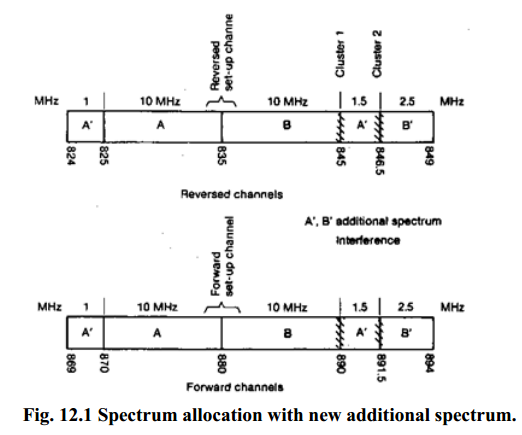What is near-end-far-end interference ratio and explain its effects?
12. What is near-end-far-end interference ratio and explain its effects?
Near-End—Far-End Interference:
In one cell: Because motor vehicles in a given cell are usually moving, some mobile units are close to the cell site and some are not. The close-in mobile unit has a strong signal which causes adjacent-channel interference (see Fig. 12(a)). In this situation, near-end-far-end interference can our only at the reception point in the cell site.
%20In%20one%20cell%20(b)%20In%20two-systems..PNG) |
| Near-end-far-end interference (a) In one cell (b) In two-systems. |
If a separation of 5dB (five channel bandwidths) is needed for two adjacent channels in a cell in order to avoid the near-end-far-end interference, it is then implied that a minimum separation of 5dB required between each adjacent channel used with one cell.
Because the total frequency channels are distributed in a set of N cell, each cell only has I/N of total frequency channels. We denote {Fl}, {F2},{F3},{F4} for the sets of frequency channels assigned in their corresponding cells C1.,C2, C3, C4.
The issue here is how can we construct a good frequency management chart to assign the N sets of frequency channels properly and thus avoid the problems indicated above. The following section addresses how cellular system engineers solve this problem in two different systems.
In cells of two systems: Adjacent-channel interference can occur between two systems in a duopoly-market system. In this situation, adjacent-channel interference can occur at both the cell site and the mobile unit.
For instance, mobile unit A can be located at the boundary of its own home cell A in system A but very close to cell B of system B as shown in the figure 12(b). The other situation would occur if the mobile unit B were at the boundary of cell B of system B but very close to cell A of system A. Following the definition of near-end-far-end interference , the solid arrow indicates that interference may our at cell site A and the dotted arrow indicates that interference may occur at mobile unit A. Of course, the same interference will be introduced at cell site B and mobile unit B.
 |
| Spectrum allocation with new additional spectrum |
Thus, the frequency channels of both cells of the two systems must be coordinated in the neighborhood of the two-system frequency bands. This phenomenon will be of greater concern in the future, as indicated in the additional frequency-spectrum allocation charts in Fig. 12.1.
The two causes of near-end—far-end interference of concern here are
1. Interference caused on the set-up channels. Two systems try to avoid using the neighborhood of the set-up channels as shown in Fig. 12.1.
2. Interference caused on the voice channels. There are two clusters of frequency sets as shown in Fig.12.1 which may cause adjacent-channel interference and should be avoided. The cluster can consist of 4 to 5 channels on each side of each system, that is, 8 to 10 channels in each cluster. The channel separation can be based on two assumptions.
a. Received interference at the mobile unit. The mobile unit is located away from its own cell site
but only 0.25 ml away from the cell site of another system.
b. Received interference at the cell site. The cell site is located 10 ml away from its own mobile unit but only 0.25 mi from the mobile unit of another system.

